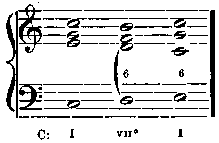Harmony Book For Beginners - online book
Scales, Intervals, Common Chords, Dominant Seventh Chord and Melody Making.
| Share page | Visit Us On FB |
|
FREER USE OF CHORDS AND INVERSIONS 107 |
||
|
In the first two Chords, (a), each in the Third Position, with Root doubled, we find Consecutive Fifths and Octaves. In the same two Chords (b), each in the Third Position, but with the Third (C) of the second Chord doubled, instead of the Root (A), we find no Consecutive Fifths or Octaves.
Here is another similar example. Let the student mark this up, and analyze for himself. |
||
|
|
||
 |
||
|
|
||
|
As we go on we shall have occasional use for this device.
This is the first time that we have doubled the Third of a Chord. In Positions we have doubled the Root only, and, in Inversions, the Fifth. In general, it is safe to say that the Root of a Chord is the best to double; the Fifth is next best; the Third should be doubled but sparingly.
So far we have not used the Chord on the Leading Note (vn° in the Scale). It is not satisfactory in the Positions but it sounds well in the First Inversion, with its Third doubled. Here is an effective way of bringing it in. |
||
|
|
||
 |
||
|
|
||
|
The second Chord is the Leading Note Chord, with its Third (D) douhled. Play this example and listen carefully.
The same Chord, occurring as the Supertonic (n°) in the Minor Scale may also be used in the same manner, in the First Inversion, with its Third Doubled. Sometimes, in the Minor Scale,it is used with its Root in the Bass. Here is an example, showing both uses: |
||
|
|
||
 |
||